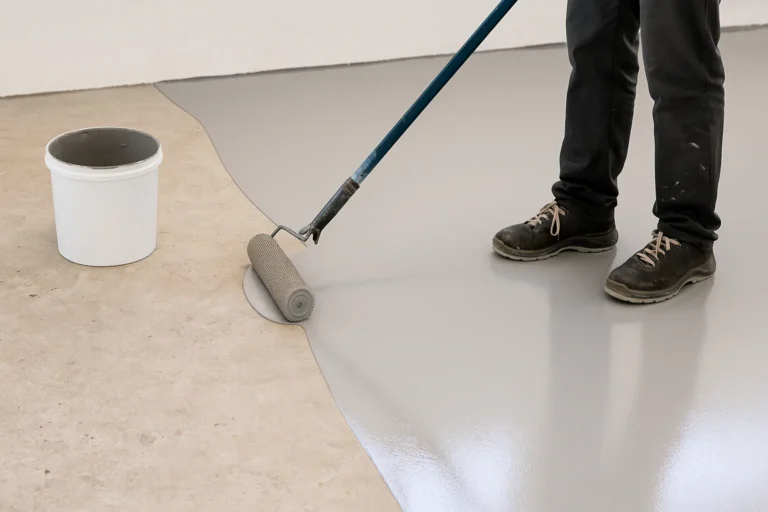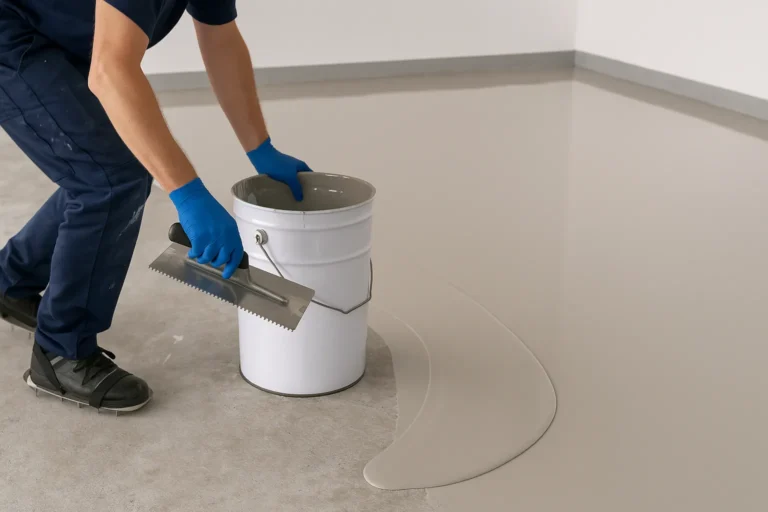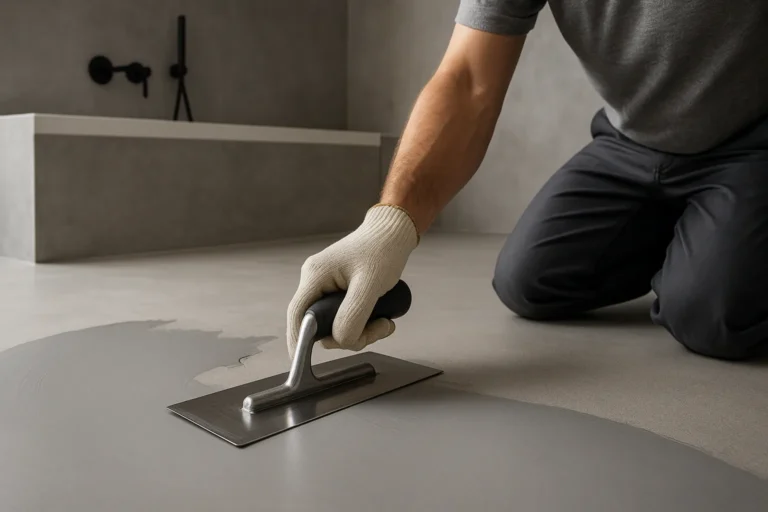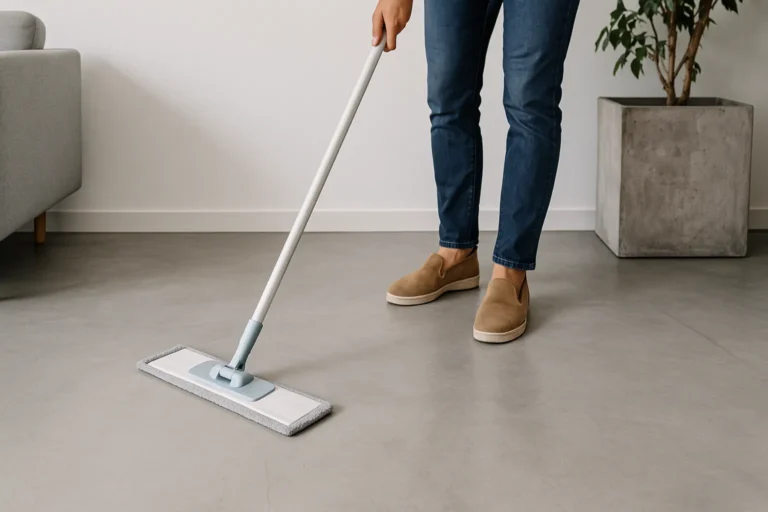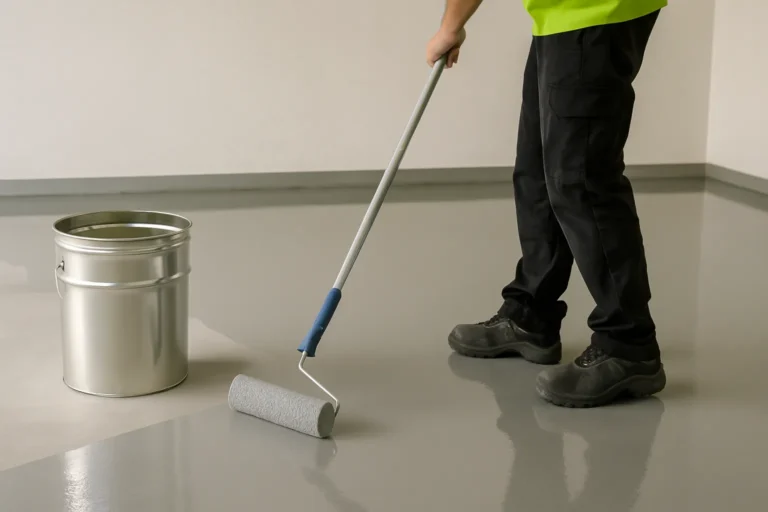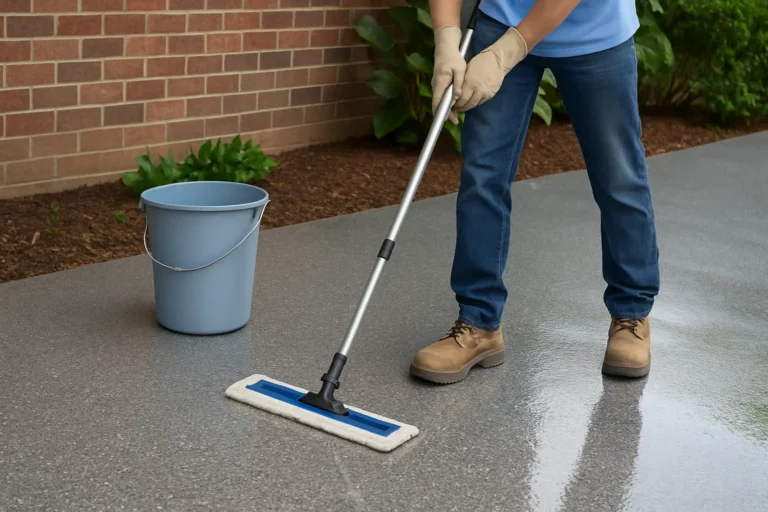Microtopping has emerged as a game-changing solution in contemporary office design, revolutionizing the way we think about workspace aesthetics and functionality. This innovative surface treatment technique has gained significant traction in recent years, offering a sleek and modern alternative to traditional desk materials.
Microtopping, a thin layer of cement-based material, can be applied to various surfaces, including existing furniture, to create a smooth, seamless finish. Its versatility and durability have made it increasingly popular among interior designers and corporate clients seeking to elevate their office environments.
The adoption of microtopping in office design has been driven by several factors:
- Aesthetic appeal and customization options
- Durability and low maintenance requirements
- Cost-effectiveness compared to traditional materials
- Ability to rejuvenate existing furniture
- Eco-friendly properties
Benefits of Microtopping for Corporate Interiors
Microtopping offers numerous advantages for corporate interiors, making it an attractive option for businesses looking to upgrade their office spaces. One of the primary benefits is its ability to create a cohesive and modern look throughout the workspace. By applying microtopping to various surfaces, companies can achieve a unified aesthetic that enhances brand identity and creates a professional atmosphere.
Moreover, microtopping’s versatility allows for seamless integration with existing design elements, making it an ideal choice for both new construction and renovation projects. Its adaptability to different colors and textures enables businesses to tailor their office environments to reflect their unique corporate culture and values.
Durability and Aesthetics of Microtopped Surfaces
The durability of microtopped surfaces is a key factor in their growing popularity for office furniture and workstations. Unlike traditional materials that may scratch, dent, or show wear over time, microtopping creates a robust surface that can withstand the daily rigors of a busy office environment.
Aesthetically, microtopping offers a sleek, modern look that can elevate the overall appearance of an office space. Its smooth, seamless finish provides a clean and sophisticated backdrop for other design elements, allowing for greater flexibility in office decor and branding initiatives.
Key features of microtopped surfaces:
- Scratch and stain-resistant
- Easy to clean and maintain
- Available in a wide range of colors and finishes
- Seamless application for a modern, minimalist look
- Ability to incorporate custom designs or patterns
Custom Workstation Finishes for Enhanced Productivity
Custom workstation finishes play a crucial role in creating an environment that fosters productivity and employee satisfaction. Microtopping allows for tailored solutions that cater to the specific needs of different departments or individual workers, ensuring that each workspace is optimized for its intended use.
By incorporating custom finishes, businesses can create workstations that not only look great but also enhance functionality. For example, integrating built-in cable management systems or wireless charging pads into microtopped desks can help reduce clutter and improve workflow efficiency.
Ergonomic Considerations in Desk Design
When designing custom workstations with microtopping finishes, ergonomics should be a top priority. Proper ergonomics can significantly impact employee comfort, health, and productivity. Microtopping’s versatility allows for the creation of ergonomically-friendly desk designs that promote good posture and reduce the risk of repetitive strain injuries.
Some ergonomic features that can be incorporated into microtopped desks include:
- Adjustable height options for sit-stand functionality
- Rounded edges to reduce pressure points
- Integrated wrist rests for keyboard and mouse use
- Customized desk shapes to accommodate different work styles
Integrating Technology with Microtopped Furniture
The seamless nature of microtopped surfaces makes them ideal for integrating technology into office furniture. With the increasing reliance on digital tools in the workplace, it’s essential to design workstations that can accommodate various devices and connectivity needs.
Microtopping allows for the incorporation of features such as:
- Built-in power outlets and USB ports
- Wireless charging pads
- Integrated touchscreens or control panels
- Hidden cable management systems
By seamlessly blending technology with furniture design, microtopped workstations can create a more streamlined and efficient work environment.
Innovative Office Furniture Solutions
As the workplace continues to evolve, innovative office furniture solutions are becoming increasingly important. Microtopping technology offers a unique opportunity to create cutting-edge furniture designs that meet the changing needs of modern businesses.
Versatile Microtopping Applications for Various Furniture Types
Microtopping’s versatility extends beyond desks to a wide range of office furniture types. This adaptability allows for a cohesive design aesthetic throughout the entire workspace. Some examples of furniture that can benefit from microtopping include:
- Conference tables
- Storage units and cabinets
- Reception desks
- Collaborative workspaces
- Break room countertops
By applying microtopping to various furniture pieces, businesses can create a unified look that enhances the overall office ambiance and reinforces brand identity.
Sustainable Materials in Corporate Interior Design
Sustainability is a growing concern in corporate interior design, and microtopping offers an eco-friendly alternative to traditional materials. The thin application of microtopping means less material is used compared to solid surface options, reducing the overall environmental impact.
Additionally, microtopping can be applied to existing furniture, extending its lifespan and reducing the need for replacement. This approach aligns with circular economy principles and can contribute to a company’s sustainability goals.
Sustainable features of microtopping:
- Low VOC emissions
- Minimal material waste during application
- Ability to refurbish existing furniture
- Long-lasting finish reduces the need for frequent replacements
Corporate Interior Innovations Using Microtopping
Microtopping is at the forefront of corporate interior innovations, offering new possibilities for creating unique and functional office spaces. Its ability to transform surfaces quickly and efficiently makes it an attractive option for businesses looking to update their interiors without extensive renovations.
Creating Cohesive Office Aesthetics with Microtopping
One of the key advantages of microtopping is its ability to create a cohesive aesthetic throughout an office space. By applying the same finish to various surfaces, from desks to walls and floors, businesses can achieve a unified look that enhances the overall ambiance of the workplace.
This cohesive approach to design can have several benefits:
- Improved visual flow throughout the office
- Enhanced brand identity reinforcement
- Creation of a more professional and polished environment
- Flexibility to adapt to changing design trends
Branding Opportunities Through Custom Finishes
Microtopping offers unique branding opportunities for businesses looking to incorporate their corporate identity into their office design. Custom colors, patterns, and even logos can be integrated into the microtopped surfaces, creating a truly personalized workspace that reflects the company’s values and culture.
Examples of branding opportunities with microtopping:
- Incorporating company colors into desk surfaces
- Adding subtle logo imprints to reception areas
- Creating custom patterns that reflect the company’s industry or mission
- Designing themed areas for different departments or teams
The Future of Office Design with Microtopping Technology
As workplace design continues to evolve, microtopping technology is poised to play a significant role in shaping the offices of the future. Its versatility, durability, and aesthetic appeal make it an ideal solution for addressing the changing needs of modern businesses.
Emerging Trends in Corporate Interior Finishes
Several emerging trends in corporate interior finishes are well-suited to microtopping applications:
- Biophilic design: Incorporating natural elements and textures
- Minimalist aesthetics: Clean lines and uncluttered surfaces
- Smart surfaces: Integration of technology into furniture and walls
- Acoustic management: Surfaces designed to reduce noise levels
- Antimicrobial properties: Finishes that promote a healthier work environment
Adapting to Changing Workplace Needs
The flexibility of microtopping makes it an excellent choice for adapting to changing workplace needs. As businesses embrace hybrid work models and flexible office layouts, the ability to quickly and easily modify surfaces becomes increasingly valuable.
Microtopping can facilitate:
- Easy reconfiguration of workspaces
- Creation of multi-functional areas
- Quick updates to reflect changing brand identities or design preferences
- Adaptation to new health and safety requirements
Installation Process for Microtopped Office Furniture
The installation process for microtopped office furniture requires careful preparation and skilled application to ensure a high-quality, long-lasting finish. Understanding this process can help businesses make informed decisions about incorporating microtopping into their office design plans.
Surface Preparation and Application Techniques
Proper surface preparation is crucial for the successful application of microtopping. The process typically involves the following steps:
- Cleaning and degreasing the existing surface
- Repairing any damages or imperfections
- Applying a primer or bonding agent
- Mixing the microtopping material to the desired consistency
- Applying multiple thin layers of microtopping
- Sanding between layers for a smooth finish
- Applying a protective sealer
The application technique may vary depending on the desired finish and the specific microtopping product used. Skilled professionals, such as those at Duraamen, can ensure a flawless application that meets the highest standards of quality and aesthetics.
Curing and Maintenance of Microtopped Surfaces
After application, microtopped surfaces require a curing period to reach their full strength and durability. This process typically takes 24-48 hours, during which time the furniture should not be used or exposed to moisture.
Once cured, microtopped surfaces are relatively low-maintenance. Regular cleaning with mild soap and water is usually sufficient to keep the surfaces looking their best. Periodic resealing may be necessary to maintain the protective finish, especially in high-traffic areas.
Maintenance tips for microtopped surfaces:
- Use coasters or pads under heavy objects to prevent scratches
- Clean spills promptly to prevent staining
- Avoid using harsh chemicals or abrasive cleaning tools
- Reapply sealer as recommended by the manufacturer
Cost-Effectiveness of Microtopping in Corporate Interiors
When considering office renovations or new furniture purchases, cost-effectiveness is a crucial factor for many businesses. Microtopping offers an attractive balance of quality, durability, and affordability that can provide significant long-term value.
Long-Term Value of Durable Office Finishes
While the initial cost of microtopping may be higher than some traditional materials, its durability and longevity can result in significant savings over time. Microtopped surfaces are resistant to wear and tear, reducing the need for frequent repairs or replacements.
Factors contributing to the long-term value of microtopping:
- Reduced maintenance costs
- Extended lifespan of furniture
- Ability to update aesthetics without full replacement
- Improved employee satisfaction and productivity
Comparing Microtopping to Alternative Materials
When evaluating the cost-effectiveness of microtopping, it’s important to compare it to alternative materials across various factors:
|
Factor |
Microtopping |
Wood |
Laminate |
Metal |
|
Initial Cost |
Moderate |
High |
Low |
High |
|
Durability |
High |
Moderate |
Low |
High |
|
Maintenance |
Low |
Moderate |
Low |
Low |
|
Customization |
High |
Moderate |
Low |
Low |
|
Lifespan |
Long |
Moderate |
Short |
Long |
|
Eco-friendliness |
High |
Moderate |
Low |
Moderate |
Customization Options for Microtopped Workstations
One of the most appealing aspects of microtopping for office furniture is the wide range of customization options available. This flexibility allows businesses to create unique workspaces that reflect their brand identity and meet specific functional requirements.
Color and Texture Variations
Microtopping offers an extensive palette of color options, from subtle neutrals to bold, vibrant hues. This versatility allows companies to match their office furniture to existing color schemes or create entirely new design concepts.
Texture variations can also be achieved with microtopping, including:
- Smooth, polished finishes
- Matte or satin surfaces
- Textured or patterned effects
- Concrete-like appearances
- Metallic or pearlescent finishes
Incorporating Company Branding into Desk Designs
Microtopping provides unique opportunities to integrate company branding directly into desk designs. This can be achieved through various methods:
- Embedding company logos or slogans into the surface
- Creating custom patterns or designs that reflect brand identity
- Using brand colors in subtle or bold ways
- Incorporating textures or finishes that align with company values
By leveraging these customization options, businesses can create a cohesive and branded office environment that reinforces their corporate identity and culture. Patio flooring makeover can transform your outdoor space New tiles or paint can give your patio a fresh look Uberdek transforms exteriors by making outdoor spaces look amazing It can turn boring patios and decks into beautiful areas for relaxing
Microtopping enhances soundproofing by adding a thin layer of special material to walls and floors This extra coating helps block out noise and makes rooms quieter
Environmental Impact of Microtopping in Office Spaces
As sustainability becomes an increasingly important consideration in office design, the environmental impact of materials and finishes is under greater scrutiny. Microtopping offers several eco-friendly benefits that make it an attractive option for environmentally conscious businesses.
Eco-Friendly Aspects of Microtopping Materials
Microtopping materials are generally considered more environmentally friendly than many traditional desk materials for several reasons:
- Low VOC emissions during and after application
- Minimal material waste due to thin application
- Ability to refurbish existing furniture, reducing landfill waste
- Long lifespan reduces the need for frequent replacements
Contribution to LEED Certification
For businesses pursuing LEED (Leadership in Energy and Environmental Design) certification, microtopping can contribute to several credit categories:
- Materials and Resources: Use of low-emitting materials
- Indoor Environmental Quality: Improved air quality
- Innovation in Design: Unique sustainable design solutions
By incorporating microtopping into office design, companies can demonstrate their commitment to sustainability and potentially improve their LEED certification level.
FAQs
Can microtopping be applied to existing office furniture?
Yes, microtopping can be applied to existing office furniture, making it an excellent option for renovating and updating workspaces without replacing all the furniture. This process involves preparing the existing surface, which may include cleaning, sanding, and applying a primer. The microtopping is then applied in thin layers, creating a new, durable surface. This approach not only saves money but also reduces waste, making it an environmentally friendly choice for office upgrades.
What are the maintenance requirements for microtopped office furniture?
Maintenance requirements for microtopped office furniture are relatively minimal. Regular cleaning with a soft cloth and mild soap solution is usually sufficient to keep the surfaces in good condition. It’s important to avoid using abrasive cleaners or scrubbers that could damage the protective sealer. Periodic resealing may be necessary, typically every few years, depending on the level of use and wear. For optimal care, follow the manufacturer’s specific maintenance guidelines to ensure the longevity of your microtopped furniture.
How does microtopping compare to traditional desk materials?
Microtopping offers several advantages over traditional desk materials such as wood, laminate, or metal. It provides a more durable and scratch-resistant surface that is easier to clean and maintain. Unlike wood, microtopping is not susceptible to water damage or warping, and it doesn’t show wear patterns like laminate surfaces often do. Additionally, microtopping allows for a seamless, modern aesthetic that can be customized to match any office design scheme, offering greater flexibility than traditional materials.
